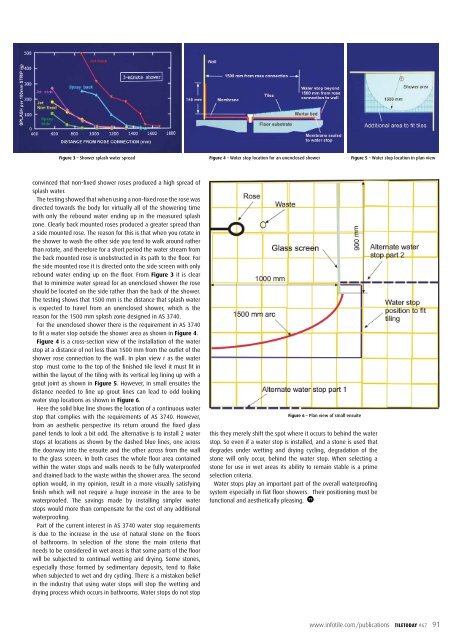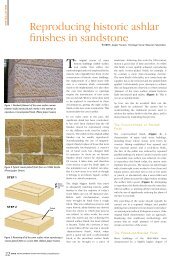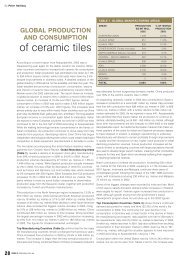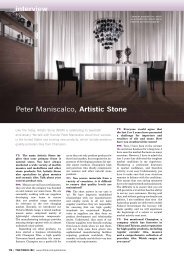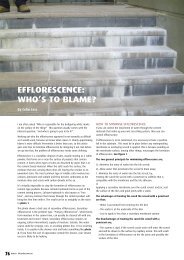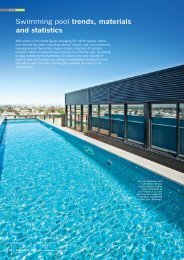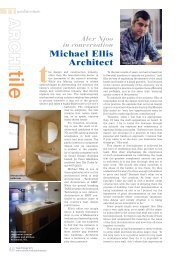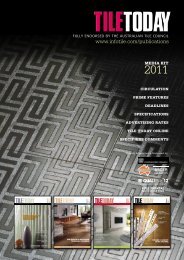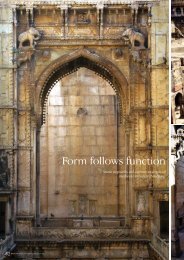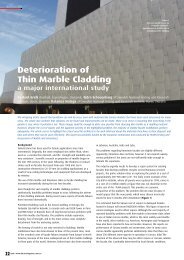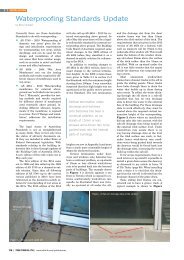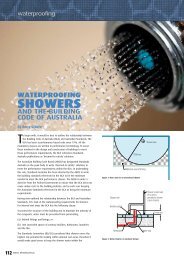Water stop position to retain water within shower area - Infotile
Water stop position to retain water within shower area - Infotile
Water stop position to retain water within shower area - Infotile
Create successful ePaper yourself
Turn your PDF publications into a flip-book with our unique Google optimized e-Paper software.
Figure 3 – Shower splash <strong>water</strong> spread Figure 4 – <strong>Water</strong> <strong>s<strong>to</strong>p</strong> location for an unenclosed <strong>shower</strong> Figure 5 – <strong>Water</strong> <strong>s<strong>to</strong>p</strong> location in plan viewconvinced that non-fixed <strong>shower</strong> roses produced a high spread ofsplash <strong>water</strong>.The testing showed that when using a non-fixed rose the rose wasdirected <strong>to</strong>wards the body for virtually all of the <strong>shower</strong>ing timewith only the rebound <strong>water</strong> ending up in the measured splashzone. Clearly back mounted roses produced a greater spread thana side mounted rose. The reason for this is that when you rotate inthe <strong>shower</strong> <strong>to</strong> wash the other side you tend <strong>to</strong> walk around ratherthan rotate, and therefore for a short period the <strong>water</strong> stream fromthe back mounted rose is unobstructed in its path <strong>to</strong> the floor. Forthe side mounted rose it is directed on<strong>to</strong> the side screen with onlyrebound <strong>water</strong> ending up on the floor. From Figure 3 it is clearthat <strong>to</strong> minimize <strong>water</strong> spread for an unenclosed <strong>shower</strong> the roseshould be located on the side rather than the back of the <strong>shower</strong>.The testing shows that 1500 mm is the distance that splash <strong>water</strong>is expected <strong>to</strong> travel from an unenclosed <strong>shower</strong>, which is thereason for the 1500 mm splash zone designed in AS 3740.For the unenclosed <strong>shower</strong> there is the requirement in AS 3740<strong>to</strong> fit a <strong>water</strong> <strong>s<strong>to</strong>p</strong> outside the <strong>shower</strong> <strong>area</strong> as shown in Figure 4.Figure 4 is a cross-section view of the installation of the <strong>water</strong><strong>s<strong>to</strong>p</strong> at a distance of not less than 1500 mm from the outlet of the<strong>shower</strong> rose connection <strong>to</strong> the wall. In plan view r as the <strong>water</strong><strong>s<strong>to</strong>p</strong> must come <strong>to</strong> the <strong>to</strong>p of the finished tile level it must fit in<strong>within</strong> the layout of the tiling with its vertical leg lining up with agrout joint as shown in Figure 5. However, in small ensuites thedistance needed <strong>to</strong> line up grout lines can lead <strong>to</strong> odd looking<strong>water</strong> <strong>s<strong>to</strong>p</strong> locations as shown in Figure 6.Here the solid blue line shows the location of a continuous <strong>water</strong><strong>s<strong>to</strong>p</strong> that complies with the requirements of AS 3740. However,from an aesthetic perspective its return around the fixed glasspanel tends <strong>to</strong> look a bit odd. The alternative is <strong>to</strong> install 2 <strong>water</strong><strong>s<strong>to</strong>p</strong>s at locations as shown by the dashed blue lines, one acrossthe doorway in<strong>to</strong> the ensuite and the other across from the wall<strong>to</strong> the glass screen. In both cases the whole floor <strong>area</strong> contained<strong>within</strong> the <strong>water</strong> <strong>s<strong>to</strong>p</strong>s and walls needs <strong>to</strong> be fully <strong>water</strong>proofedand drained back <strong>to</strong> the waste <strong>within</strong> the <strong>shower</strong> <strong>area</strong>. The secondoption would, in my opinion, result in a more visually satisfyingfinish which will not require a huge increase in the <strong>area</strong> <strong>to</strong> be<strong>water</strong>proofed. The savings made by installing simpler <strong>water</strong><strong>s<strong>to</strong>p</strong>s would more than compensate for the cost of any additional<strong>water</strong>proofing.Part of the current interest in AS 3740 <strong>water</strong> <strong>s<strong>to</strong>p</strong> requirementsis due <strong>to</strong> the increase in the use of natural s<strong>to</strong>ne on the floorsof bathrooms. In selection of the s<strong>to</strong>ne the main criteria thatneeds <strong>to</strong> be considered in wet <strong>area</strong>s is that some parts of the floorwill be subjected <strong>to</strong> continual wetting and drying. Some s<strong>to</strong>nes,especially those formed by sedimentary deposits, tend <strong>to</strong> flakewhen subjected <strong>to</strong> wet and dry cycling. There is a mistaken beliefin the industry that using <strong>water</strong> <strong>s<strong>to</strong>p</strong>s will <strong>s<strong>to</strong>p</strong> the wetting anddrying process which occurs in bathrooms. <strong>Water</strong> <strong>s<strong>to</strong>p</strong>s do not <strong>s<strong>to</strong>p</strong>Figure 6 – Plan view of small ensuitethis they merely shift the spot where it occurs <strong>to</strong> behind the <strong>water</strong><strong>s<strong>to</strong>p</strong>. So even if a <strong>water</strong> <strong>s<strong>to</strong>p</strong> is installed, and a s<strong>to</strong>ne is used thatdegrades under wetting and drying cycling, degradation of thes<strong>to</strong>ne will only occur, behind the <strong>water</strong> <strong>s<strong>to</strong>p</strong>. When selecting as<strong>to</strong>ne for use in wet <strong>area</strong>s its ability <strong>to</strong> remain stable is a primeselection criteria.<strong>Water</strong> <strong>s<strong>to</strong>p</strong>s play an important part of the overall <strong>water</strong>proofingsystem especially in flat floor <strong>shower</strong>s. Their <strong>position</strong>ing must befunctional and aesthetically pleasing.www.infotile.com/publications TILEToDAY #67 91


